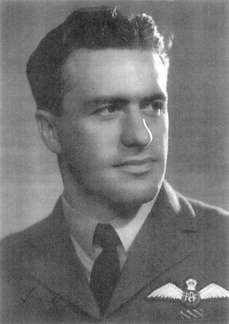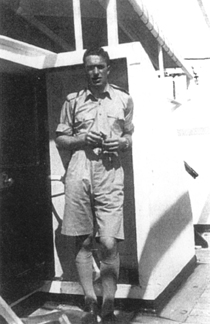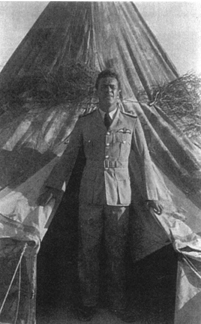 |
 |
||||
|
Squadron Leader KCVD “Ken” Dundas 41000 RAF DFC GFC: KIA 10 February 1942 Several years ago, in my continuing research about 211 Squadron, I came by chance across an on-line request from John Hodgins for information about 211 Squadron in the Far East. It turned out that John’s mother Daphne was younger sister to Kenelm Crispin Vivian Douglas Dundas. A Canadian of Pelly, Saskatchewan, son of Cospatrick Phillip Brooke Dundas and his wife Elizabeth neé McKenzie, Ken Dundas was a decorated and highly regarded veteran of 211 Squadron operations in the Middle East and Far East, lost over Malaya in February 1942. In Lethbridge, Alberta, Daphne Hodgins and her husband Rankin were able to assemble enough material about Ken to self-publish The Life of Kenelm CVD Dundas in November 2000. I have much enjoyed our cheerful correspondence. Thanks to the kind agreement of the Hodgins family, by drawing upon their own “little book” and with the benefit of other Squadron records, we may now all see something of Ken’s part in the 211 Squadron story. Daphne, despite illness in early 2006, had recovered well enough to thoroughly enjoy a short summer cruise with Rankin and three of their sons but soon afterward became ill again. Daphne RL Hodgins died peacefully on 8 August 2006 aged 83 years. Long resident in Lethbridge, Alberta, Rankin Hodgins died on Christmas Day 2018. He was 97.
Beginnings Finding limited flying training opportunities in the RCAF, Dundas considered joining the RAF. Seeking short-service commission entry, after 18 months service he left the RCAF in March 1938, travelling under his own steam to the United Kingdom to make his application. In London he found a warm welcome from relatives, and their practical support for his RAF ambitions. By Midsummer's Day 1938 his application had been accepted and Dundas was posted to Perth in Scotland. There a new airfield had been established in 1936, at Scone, along with No 11 Elementary and Reserve Flying Training School. That summer, he was flying solo by 3 July 1938, the first in his course to do so. By August he had completed his initial training with 47 flying hours in his Log Book, to be appointed Acting Pilot Officer on probation on 20 August 1938.
To the Middle East Dundas was awarded his pilot's wings in December 1938, and promoted to Pilot Officer the following June. Life in the pre-war RAF was much to his liking as a newly commissioned young officer on an overseas posting. There was much enjoyment to be had, with training and flying duties followed by the vibrant social life of Cairo in that last winter and spring before the war. To 211 Squadron
Then, 211 Squadron had been among the first to strike at the Italians. By September, with the Italians advancing to Sidi Barrani, the level of operations had increased such that in three weeks the Squadron carried out more sorties than had been undertaken over the preceding three months. Throughout his service in the Middle East, Dundas was a regular correspondent with his family in Canada. Though unable to say much about the Squadron's operations, among more definite news, his letter of 5 December 1940 mentioned seeing a newsreel clip of himself and crew returning from a desert raid. Despite long searching of archival newsreel footage from the AWM and elsewhere, this clip remained elusive until 2007. Footage of El Daba, of a possibly 211 Squadron aircraft in the air, and of the crew alighting in a desert setting from a Blenheim I clearly bearing the UQ identity (possibly UQ-M) is briefly seen in Volume III of The RAF At War (Pegasus DVD 1068). It seems very likely that this is the clip referred to by Dundas. By chance, it came to hand on 31 July 2007. In Wings Over Olympus, Dundas is recalled among “the host of other good fellows” as “the big, slow-talking Canadian”, and “quick to smile and slow of speech, the ideal bomber pilot—cautious and thorough”. To Greece In December 1940 the Squadron’s Operations Record Book records the difficulties encountered that winter, in operations from Menidi on the outskirts of Athens against targets far to the North across the Pindus Mountains: 15/12/40 A further two aircraft took off for Yannina, from which aerodrome an attempt was to be made at a photographic reconnaissance of Durazzo and Si Giovanni di Medua. One aircraft damaged its tail wheel on landing at Yannina and was unable to continue the operation. The aircraft which landed at Yannina on 14/12/40 returned to base [Menidi] having completed a successful visual reconnaissance of Durazzo and Si Giovanni di Medua. No photographs were obtained owing to camera failure. The aircraft landed with its under-carriage retracted due to Port engine seizure. The Air Gunner suffered severe frostbite which necessitated his admission to hospital. 16/12/40 No flying owing to a high wind with sleet rain and low cloud. 17/12/40 The aircraft piloted by F/O Dundas which proceeded to Yannina on 15/12/40 took off in an attempt to carry out the photographic reconnaissance previously mentioned, but low cloud and rainstorms forced the pilot to return to base. Three aircraft carried out an offensive reconnaissance of the Barande—Valona road. The attack on MT vehicles on this road was carried out in a snow-storm which made it impossible to observe results. On 9 February 1941 the Squadron was ordered to detach six aircraft (two flights) to a forward field at Paramythia in north-western Greece, close to the Albanian border They were to move forward with the minimum number of airmen required to maintain the aircraft for operations. With assistance from ground service personnel and from 22 and 23 Mira (Greek Air Force units who had arrived with their PZL P24 bi-plane fighters the day before), the detachment was able to operate on all but one day of February despite continued poor weather. By the end of the month the whole Squadron was moving to join them. Apart from the heavy workload of operations mounted from Paramythia, in February and March 1941 F/O Dundas was also acting first as ‘B’ Flight commander (as recorded in Wings Over Olympus) and later as ‘A’ Flight commander (as recorded in my father's Log Book). In the London Gazette of 8 April 1941, his service was formally recognised with the award of the Distinguished Flying Cross, “in recognition of gallantry and devotion to duty in the execution of air operations”. In the style of the time, this formulation meant that F/O Dundas had achieved the equivalent of a completed tour of operations. He was in good company: DFCs for 211 Squadron pilots F/O Basil “Buck” Buchanan and P/O Ronald “Twinkle” Pearson appeared in the same issue. The Squadron had had the news of their awards a little earlier, on 6 April, the day that Germany formally declared war on Greece. On Easter Sunday, 13 April 1941, the Squadron was tasked with three raids during the course of the day. On the last raid, against German forces streaming through the Monastir Gap, there was no fighter escort for the six aircraft that were dispatched. None returned. This disastrous loss included the Squadron CO, S/Ldr Irvine, the Commander of the Western Wing (W/Cdr Coote) and his deputy S/Ldr Cryer. With half the Squadron’s aircrew including the CO and one Flight commander lost in this one operation, Dundas found himself promoted to Flight Lieutenant and temporary command of the Squadron. Thus he continued, during the difficult period of evacuation from Paramythia and shortly afterwards from Greece (where he remained, in charge of the Rear Party, until 26 April). To Syria A rest at last To the Far East F/Lt Dundas was now deservedly promoted Squadron Leader and Officer Commanding half the Squadron under the new Squadron CO, Wing Commander RN Bateson DFC (with much experience in the Western Desert with 113 Squadron). The Squadron’s aircrew were a mixture of newly qualified Australians and a number of very experienced 211s: apart from Dundas and Bateson, other old hands from Greece were Bill Baird, Gordon Chignall, Hugh Clutterbuck and Jimmy Riddle. Among the groundcrew, proceeding by sea and only to meet up with the air echelon at the last gasp in Java, were Len Abbs, Mick Dudman and Jim Fryatt. W/Cdr Bateson’s flight of 6 Blenheim Mark IVs left Helwan on 25 January 1942. The three other flights of six 211 Squadron aircraft left at daily intervals thereafter. The Squadron’s long ferry flight is described in summary on the Far East page and from the personal point to view in John Keeping’s narrative. The last flight of six took off from Helwan on the morning of Wednesday 28 January 1942, led by S/Ldr Dundas in Z7643 with 749525 F/Sgt GA Riddle (Observer) and 651720 Sgt GNV Chignall (WOp/AG). They arrived at Pakenbaroe on 4 February, where Z7643 developed an engine fault. Dundas, as Officer in command of the afterguard once again, accordingly took over the next available aircraft, Z7699 and two of its Australian crew (Observer G Ritchie and WOp/AG JB Keeping), leaving his own capable crew (Riddle and Chignall) with Australian pilot Bev West to recover Z7643. The adventures of Dundas, Riddle and Chignall in Z7643 are recounted on the Blenheim IV page, with very rare photos of this 211 Squadron aircraft in the Far East. Around Saturday 7 February, 211 Squadron was sufficiently organised at Palembang’s satellite field P2 to be able to mount operations. Under pressure and with limited resources, the Squadron was soon taking heavy losses. The RAAF summary record of aircraft lost with RAAF crew is sparsely suggestive of the difficulties experienced in Sumatra. They were to withdraw from Palembang to Java within days. Blenheim IV (Z7699) 6/2/42 [sic] 211 Sqdn Sumatra-Malaya Notably, an error has crept into the RAAF record. There is no doubt that the raid took place on 10 February 1942, taking off at 0200hrs that morning from Palembang P2 as Baird and Bateson recorded in their Log Books. On safely returning to P2 at about sunrise to the news and a rumour that Dundas had been hospitalised, Bateson took off again almost immediately to carry out a local search. It was fruitless: the missing men lay dead in Malaya. The loss of Dundas, Ritchie and Keeping over Kluang was reported by Bateson in April 1942 after arriving in Melbourne. Bill Baird and Dru Paterson also recalled that operation vividly. Ken Dundas’ Far East service was subsequently recognised with a Mention in despatches (London Gazette 11 June 1942), and his work in Greece with the award of the Greek Flying Cross (London Gazette 29 December 1942). In 1945, in the course of war grave recovery work, the wreckage of Z7699 was found in Mankibol Rubber Estate near Kluang, 60 miles north of Singapore. Although the remains of George Ritchie and John Keeping were identifiable in the original Japanese burial site, sadly, the body of Squadron Leader Kenelm CVD Dundas DFC was not recoverable. Sources Baird correspondence with author Dundas: London Gazette issues 1938 to 1942 Hodgins family correspondence with author Keeping: Ritchie RAAF Casualty file NAA A705/15 Item 163/55/168 Remembered with honour In Memory of
www.211squadron.org © D Clark & others 1998—2025 |
||||


